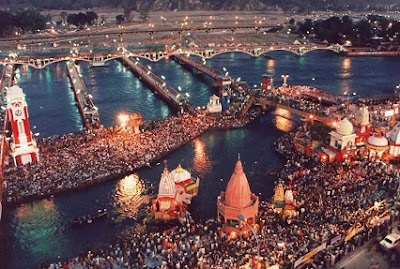Kumbh means pot or pitcher, while mela means festival or fair. According to ancient Hindu mythology, Lord Vishnu releaed drops of an immortality nectar (carried in a kumbh) in four places where the holiday is now celebrated — Nashik, Prayagraj, Ujjain and Haridwar. The festival rotates approximately every three years through these cities, with the exact dates, places and length largely determined by astrology. In 2017, UNESCO added the festival to the List of Intangible Cultural Heritage, citing the event’s “central spiritual role in the country.”
The main ritual of Kumbh Mela is bathing in the rivers. Washing in holy waters is believed to deliver worshippers from their past sins and lead them to moksha, or liberation from the cycle of birth and death. Ascetics known as sadhus also play essential roles in the tradition. There are a variety of sadhus, some of which are recognizable by their matted hair and naked bodies coated in ash. Although they generally lead lives of isolation, at Kumbh Mela these holy men come to together en masse in pursuit of enlightenment.
Mythological significance:
Mythological significance of Kumbh revolves around the story of the samudra manthan which was done by the gods and demons to obtain the invaluable ratnas or the jewels and amrita or the nectar of immortality.

The first to emerge in this churning was a venomous poison which was consumed by the Lord Shiva who upon drinking this poison came to be called as the Nilkantha.
The churning continues and emerged Kamdhenu, the Uccaishrava Jayanta, the son of Lord Indra , catching sight of the amrita kalasa or the pot filled with nectar, snatched it from the the hands of God Dhanvantari. Noticing this, Lord Shukracharya , the Guru of demons alerted and demons chased Jayanta. According to the divine counting one day of Gods is equal to the one year of mortal beings and the Jayanta kept on running for 12 days to avoid amrit kalasha to fall in the hands of demons.
Types of Kumbh Melas:
Maha Kumbh Mela: It is held only in Prayagraj. It comes in every 144 years or after 12 Purna (Complete) Kumbh Mela.
Purna Kumbh Mela: It comes every 12 years. Mainly held at 4 Kumbh Mela Places in India i.e. Prayagraj, Haridwar, Nashik and Ujjain. It rotates every 12 years at these 4 places.
Ardh Kumbh Mela: It means Half Kumbh Mela which is held every 6 years in India only at two places i.e. Haridwar and Prayagraj.
Kumbh Mela: Held at four different places and is organised by the state governments. Millions of people participate with spiritual enthusiasm.
Magh Kumbh Mela: It is also known as Mini Kumbh Mela which is held annually and only at Prayagraj. It is organised in the month of Magh according to the Hindu Calendar.
The venue for Kumbh Mela is decided according to the position of the Sun, Moon and Jupiter hold in that period in different zodiac signs.
Since then, Kumbh Mela is celebrated with all the ritual beliefs and people from different aspects gather to celebrate the event.
View of kumbhmela from space









